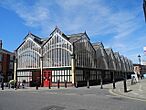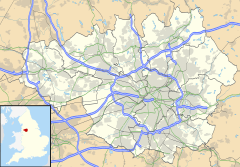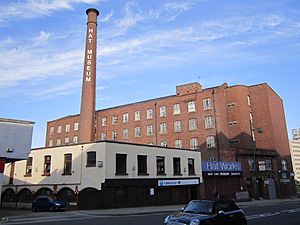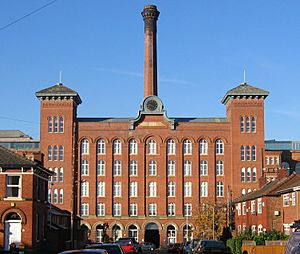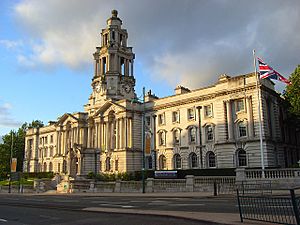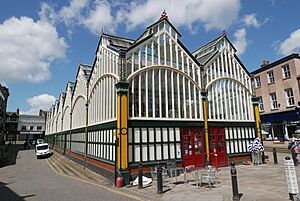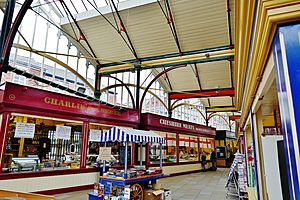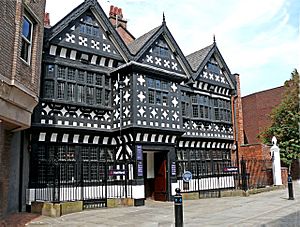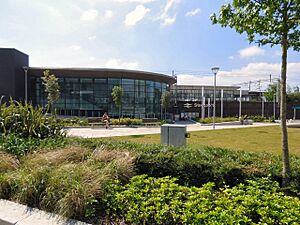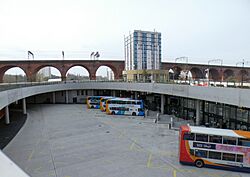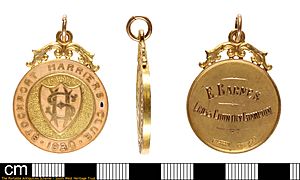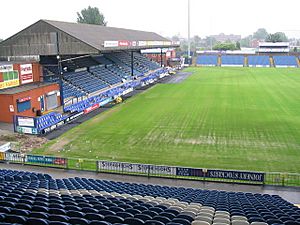Stockport facts for kids
Quick facts for kids Stockport |
|
|---|---|
|
|
|
| Population | 137,130 (2011 census) |
| • Density | 2,208 per mi² (852 per km²) |
| Demonym | Stopfordian |
| OS grid reference | SJ895900 |
| • London | 157 mi (253 km) SE |
| Metropolitan borough |
|
| Metropolitan county | |
| Region | |
| Country | England |
| Sovereign state | United Kingdom |
| Post town | STOCKPORT |
| Postcode district | SK1-SK7 |
| Dialling code | 0161 |
| Police | Greater Manchester |
| Fire | Greater Manchester |
| Ambulance | North West |
| EU Parliament | North West England |
| UK Parliament |
|
Stockport is a busy town in Greater Manchester, England. It is about 8 miles (13 km) south-east of Manchester. The Rivers Goyt and Tame meet here to form the River Mersey. In 2011, Stockport had a population of 137,130 people.
Most of Stockport is in the historic county of Cheshire. The area north of the Mersey River is in Lancashire. In the 1500s, Stockport was a small town known for growing hemp and making rope. Later, in the 1700s, it had one of the first machine-powered silk factories in Britain.
In the 1800s, Stockport became famous for its cotton and hat-making industries. By 1884, it was exporting over six million hats a year! The last hat factory closed in 1997. The town's football team, Stockport County, is even nicknamed "The Hatters."
A huge structure called the Stockport Viaduct stands tall on the western side of town. It was built in 1840. Its 27 brick arches carry the main railway line over the River Mersey.
Contents
- Exploring Stockport's Past
- How Stockport is Governed
- Stockport's Location and Landscape
- People of Stockport
- Stockport's Economy
- Famous Places in Stockport
- Getting Around Stockport
- Learning in Stockport
- Places of Worship
- Stockport's Culture and Arts
- Media in Stockport
- Sports in Stockport
- Town Twinning
- Freedom of the Borough
- Images for kids
- See also
Exploring Stockport's Past
What's in a Name?
Stockport was first called "Stokeport" in 1170. Its name likely comes from old English words. Stoc means a small settlement or hamlet, and port means a market place. So, Stockport means "a market place at a hamlet."
Some older ideas suggested it meant "a castle in a wood." This might refer to Stockport Castle, a 12th-century castle first mentioned in 1173.
People from Stockport are often called "Stopfordians." This name comes from an older version of the town's name, "Stopford."
Ancient Times in Stockport
People have lived in the Stockport area for a very long time. Tools from hunter-gatherers of the Middle Stone Age (about 8000–3500 BC) have been found. Weapons and tools from the New Stone Age (3500–2000 BC) have also been discovered.
Later, during the Roman period (around 70 AD), it's thought that Roman roads crossed near the town centre. Roman coins and pottery have been found in the area.
Medieval Stockport and Beyond
Stockport was not mentioned in the Domesday Book of 1086. This might mean it was a small market place connected to a larger estate.
A castle in Stockport was used by rebels against King Henry II in 1173–1174. This castle was likely taken down by the mid-1500s.
During the English Civil War in the 1640s, Stockport supported the Parliament. In 1644, Prince Rupert and his Royalist army marched through the town.
In 1745, the Stockport bridge was taken down to try and stop the Jacobite army of Charles Edward Stuart from passing through.
Stockport's Industrial Past
Hat-making began in this area by the 1500s. By the 1600s, Stockport became a major centre for making hats and later for silk. The town grew very quickly during the Industrial Revolution. This was thanks to the booming cotton industry.
Stockport was one of the first "textile towns." In 1732, the town's first silk mill opened. It was the first water-powered textile mill in the north-west of England. More mills followed, powered by the local rivers.
By the 1800s, hat-making became a huge industry in Stockport. It was one of the town's main employers. However, after the First World War and changes in fashion, the demand for hats dropped. The last hat factory in Stockport closed in 1997. Today, the Hat Works museum celebrates this important part of the town's history.
Modern Stockport Today
Since the 1900s, Stockport has changed from a town focused on cotton to one with many different types of businesses. It celebrates its history with places like the Hat Works museum. You can also visit the Stockport Air Raid Shelters, which are tunnels dug during the Second World War to protect people from air raids. Staircase House is a medieval building that tells the story of Stockport.
In 1967, the Stockport air disaster happened. A plane crashed in the Hopes Carr area, and 72 people died.
Stockport Council is working on a big plan called "Future Stockport." This plan aims to bring more people to live in the town centre and improve shops and homes. Many old industrial areas are being turned into new homes and businesses.
How Stockport is Governed
Stockport is governed by the Stockport Metropolitan Borough Council. This council meets at Stockport Town Hall. The council is part of the Greater Manchester Combined Authority, which is led by the Mayor of Greater Manchester.
Stockport has a long history of local government. It became a "municipal borough" in 1836. This meant it had its own local council. In 1889, it became a "county borough," which gave it even more independence.
In 1974, Stockport became part of the new metropolitan county of Greater Manchester. In 2011, Stockport tried to become a city but was not chosen.
Who Represents Stockport in Parliament?
There are four areas in the Stockport Metropolitan Borough that elect Members of Parliament (MPs). These are Stockport, Reddish and Denton, Cheadle, and Hazel Grove.
Stockport's Location and Landscape
| Weather chart for Stockport | |||||||||||||||||||||||||||||||||||||||||||||||
|---|---|---|---|---|---|---|---|---|---|---|---|---|---|---|---|---|---|---|---|---|---|---|---|---|---|---|---|---|---|---|---|---|---|---|---|---|---|---|---|---|---|---|---|---|---|---|---|
| J | F | M | A | M | J | J | A | S | O | N | D | ||||||||||||||||||||||||||||||||||||
|
70
6
1
|
50
7
1
|
60
9
3
|
50
12
4
|
60
15
7
|
70
18
10
|
70
20
12
|
80
20
12
|
70
17
10
|
80
14
8
|
80
9
4
|
80
7
2
|
||||||||||||||||||||||||||||||||||||
| temperatures in °C precipitation totals in mm |
|||||||||||||||||||||||||||||||||||||||||||||||
|
Imperial conversion
|
|||||||||||||||||||||||||||||||||||||||||||||||
Stockport is located on high ground, about 6.1 miles (9.8 km) south-east of Manchester city centre. It sits where the Goyt and Tame rivers meet to form the River Mersey.
The ground beneath Stockport is made of sandstones and mudstones. These were covered by thick layers of sand and gravel left by glaciers about 15,000 years ago.
Neighbouring Areas and Suburbs
 |
Levenshulme | Abbey Hey | Denton |  |
| Didsbury | Bredbury Romiley Marple |
|||
| Cheadle | Bramhall | Hazel Grove |
People of Stockport
| Stockport Compared | |||
|---|---|---|---|
| 2001 UK census | Stockport | Stockport MB | England |
| Total population | 136,082 | 284,528 | 49,138,831 |
| White | 95.5% | 95.7% | 91% |
| Asian | 2.0% | 2.1% | 4.6% |
| Black | 0.5% | 0.4% | 2.3% |
| Christian | 74.9% | 75.4% | 72% |
| Muslim | 1.8% | 1.8% | 3.1% |
| No religion | 15.3% | 14.2% | 15% |
In 2001, Stockport had a population of 136,082 people. The population density was about 11,937 people per square mile (4,613 per km²). For every 100 females, there were 94 males.
About 32% of people over 16 were single, and 50.2% were married. Stockport's households included 33.1% one-person homes and 33.7% married couples living together.
While some areas like Woodford and Bramhall are quite wealthy, other parts like Edgeley and Brinnington are among the poorer areas. The "Four Heatons" (Heaton Moor, Heaton Mersey, Heaton Chapel, and Heaton Norris) are in the north-west of the borough.
How Stockport's Population Has Changed
| Population growth in Stockport since 1901 | |||||||||||||||||||||||||||||||||||||||||||||||
|---|---|---|---|---|---|---|---|---|---|---|---|---|---|---|---|---|---|---|---|---|---|---|---|---|---|---|---|---|---|---|---|---|---|---|---|---|---|---|---|---|---|---|---|---|---|---|---|
|
|
|
|||||||||||||||||||||||||||||||||||||||||||||
| Source: County Borough 1901–1971; Urban Subdivision 1981–2001 | |||||||||||||||||||||||||||||||||||||||||||||||
Stockport's Economy
The main shopping area in Stockport is the town centre. You can find many well-known shops in the Merseyway Shopping Centre or The Peel Centre. Redrock Stockport has a cinema, restaurants, and bars.
Stockport is only about 6 miles (10 km) from Manchester. This makes it easy for people to travel for work or shopping. The council has plans to improve the town centre, including new homes and shops. There are also talks about a Metrolink tram route to Manchester.
Famous Places in Stockport
Stockport Town Hall is a beautiful building with a "magnificent" ballroom. It has a special Wurlitzer organ inside.
The Stockport Viaduct is a huge railway bridge, 111 feet (34 metres) high. It carries four railway tracks over the River Mersey. This amazing Victorian structure was built in just 21 months!
Near the M60 motorway, you can see the Stockport Pyramid. This unique building has a steel frame covered in blue glass. It was built in 1992 and is now used as a call centre.
Vernon Park is a lovely park to the east of town. It opened in 1858 and was named after Lord Vernon, who gave the land to the town.
St Elisabeth's Church, Reddish, and its nearby model village were designed for workers of Houldsworth Mill, Reddish.
Getting Around Stockport
Train Travel
Stockport railway station is a major train station. It's on the line that connects London Euston to Manchester Piccadilly. Many different train companies use this station, offering services to places like Birmingham, Nottingham, Liverpool, and Cardiff.
Bus Services
The new Stockport Interchange opened in March 2024. It is a hub for bus services across the borough. Buses connect Stockport to its suburbs and other towns like Ashton-under-Lyne, Hyde, and Altrincham.
Roads and Motorways
The M60 motorway, which goes around Manchester, and the A6 road both cross at Stockport. The A6 connects Carlisle in the north to Luton in the south.
Air Travel
Manchester Airport is about 5 miles (8 km) south-west of Stockport. It is one of the busiest airports in the UK outside of London.
Learning in Stockport
Stockport College is located in the town centre. Stockport is also home to Stockport Grammar School, which was founded in 1487 and is one of the oldest schools in the north-west of England.
Places of Worship
St Mary's Church is the oldest church in Stockport. Parts of it date back to the early 1300s. It is located by the market place and has a heritage centre run by volunteers. Other important churches include the Roman Catholic St Joseph's Church and Our Lady and the Apostles Church.
Stockport's Culture and Arts
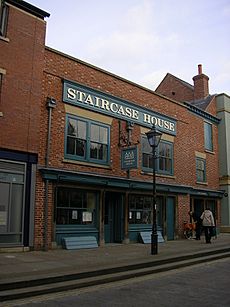
Stockport has several interesting museums. The Hat Works museum is in a former hat factory. The Stockport Air Raid Shelters let you explore tunnels used during World War II. Staircase House is a medieval townhouse that tells the story of Stockport.
The Plaza is a beautiful old cinema and theatre built in 1932. It's special because it still operates in its original style.
In 2018, a new entertainment complex called Redrock Stockport opened. It has a cinema, restaurants, and bars.
Strawberry Studios was a famous recording studio in Stockport from 1968 to 1993. Many famous artists recorded there, including 10cc, Joy Division, and the Smiths.
Local writer Simon Stephens' play Port is set in Stockport. The painter Alan Lowndes often featured Stockport scenes in his artwork. The indie pop band Blossoms are from Stockport.
Media in Stockport
Television
Local news for Stockport is provided by BBC North West and ITV Granada.
Radio
Stockport is served by several local radio stations, including BBC Radio Manchester and Heart North West. There is also a community radio station called Your FM.
Newspapers
The Stockport Express is the town's local newspaper, published every Wednesday.
Sports in Stockport
Athletics
Stockport has three athletics clubs: Manchester Harriers & AC, Stockport Harriers & AC, and DASH Athletics Club. Many talented athletes train here.
Football
Stockport County F.C. is the town's main football club. They play in EFL League One. The club started in 1883 as Heaton Norris Rovers and changed its name to Stockport County in 1890. They joined the English Football League in 1900. Their best season was in 1996–97 when they reached the League Cup semi-finals.
There are also several other local football clubs in the area, such as Stockport Georgians A.F.C. and Cheadle Heath Nomads F.C..
Lacrosse
Stockport Lacrosse Club was founded in 1876 and is thought to be the oldest lacrosse club in the world. They have men's, ladies', and junior teams.
Rugby
Sale Sharks Rugby Union Club used to play at Edgeley Park from 2002 to 2012. Manchester Rugby Union Club plays in Cheadle Hulme.
Swimming
Stockport Metro Swimming Club is based at Grand Central Pools. Swimmers from this club have won Olympic medals, including Graeme Smith (bronze in 1996), Steve Parry (bronze in 2004), and Keri-anne Payne (silver in 2008).
Tennis
Stockport is the birthplace of Fred Perry, a famous tennis player who was once ranked World No.1. He won eight Grand Slam singles titles. Tennis professionals Liam Broady and his sister Naomi Broady were also born in Stockport.
Town Twinning
Stockport is twinned with three towns around the world:
 Béziers, France (since 1972)
Béziers, France (since 1972) Heilbronn, Germany (since 1982)
Heilbronn, Germany (since 1982) Dodge City, United States (since 2002)
Dodge City, United States (since 2002)
Freedom of the Borough
Some special people and military groups have been given the "Freedom of the Borough" of Stockport. This is a great honour.
- Fred Perry: 1934.
- Christopher Finney: 5 September 2007.
- The Cheshire Regiment: 1969.
- 1st Battalion The Mercian Regiment: 11 November 2010.
Images for kids
-
The Stockport railway viaduct over the River Mersey.
See also
 In Spanish: Stockport para niños
In Spanish: Stockport para niños





